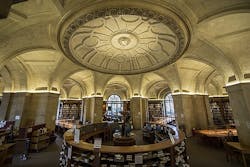LED tape brings sparkle to neo-classical Oxford Radcliffe Camera
Penn Elcom supplies 250m of Osram LED tape to retrofit the Radcliffe Camera building that serves as a reading room on the Oxford University campus in England.
The Radcliffe Camera has received a major solid-state lighting (SSL) upgrade with the installation of Osram Linearlight Flex LED-based strips or tape on both architectural features of the library interior and in historic reading lamps on desks. Penn Elcom supplied 250m of the tape for the project along with Comus aluminum profiles upon which the tape was mounted. The iconic building at Oxford University that serves primarily as a reading room now has much better light levels for reading, dramatic highlighting of internal architectural features, and an installation intended to be largely maintenance free for 50,000 hours.
Interested in articles & announcements on LED lighting projects?
The Radcliffe Camera was constructed over the period of 1737 to 1748 and designed by famed UK architect James Gibbs. It originally housed the Radcliffe Science Library and the construction was funded by the estate of John Radcliffe, a local doctor. It became known as the Radcliffe Camera in the mid-1800s when it transitioned to its current use as a reading room for the Oxford Bodleian library.
Like many historical structures, the Radcliffe Camera required a delicate touch in terms of a new lighting design. The building is Grade 1 Listed, meaning it is on the list maintained by the UK Statutory List of Buildings of Special Architectural or Historic Interest. Any major changes to such a building require special permission. Moreover, the reading lamps on the desks are also listed and thereby protected from substantive change.
LEDs have proven especially viable as light sources in historic buildings indoors and out. We have covered SSL installations at a number of United Nations Educational, Scientific and Cultural Organization (UNESCO) World Heritage Sites. For example, we covered a major project at the Durham Castle in the UK. LED lighting is typically easier to install than the legacy lighting it replaces, and uses less power so no new infrastructure is required for a lighting upgrade and there is minimal impact on the architecture.
In the case of the Radcliffe Camera, the main room features architectural pediments alternated with recessed niches, and Corinthian columns divide the space. Indeed, the architectural features were well-suited for a new lighting design that could both reveal the room detail and deliver better quality lighting for students using the space.
Oxford's Rob Gregg led the lighting design effort with consultative help from Richard Francis of local contractor Monard Electrical and Razvan Vasiliu of Penn Elcom. The trio ultimately decided that the Osram Linearlight Flex could meet the goals of the project while also offering a five year warranty. The LED tape could be installed discreetly and in a manner that was sensitive to the internal architecture, and it was judged to deliver the quality of light required for the application. Ultimately, the group decided on using warm 3000K-CCT tape that was supplied by Penn Elcom. Penn's Vasiliu ensured that the tape supplied used LEDs from the same bin for uniformity and that the bin was documented in case additional lighting is added in the future.
The LED tape was installed around the stone cornicing in the roof, around the tops of the columns, and along edges of ground floor balconies. The result is illumination in the domed ceiling areas that also indirectly provides ambient light for the space. Meanwhile, the tape was also installed in the desk lamps for task lighting on 30 individual desks spread through the space.
Penn Elcom also supplied Osram OT20, OT75, and OT120 drivers for the project. Upon initial installation, the lighting is only capable of on-off control, although the drivers could support dimming if that functionality is deemed necessary going forward.
The exact quantifiable benefits of the project remain to be accounted for. But Vasiliu said electrical costs have plummeted relative to the fluorescent lighting that was replaced. Moreover, there has been roughly a 10-fold increase in lux levels in the space.
The projected maintenance-free operation of the SSL installation is due in part to the way the tape was installed, according to Vasiliu. Penn Elcom manufactures its own Comus aluminum profiles and using those profiles was deemed critical in the reliable operation of the LEDs. The profiles essentially serve as a heat sink and thermal issues are a predominant cause of premature LED failures. The profiles also provide a sure and uniform mounting surface to which the tape can be solidly affixed, whereas tape mounted directly to architectural surfaces might peel away.
LEDs have been used in many unique ways in educational and library settings. Several years ago we covered a project at the Pasadena Central Library in California where LED kits were used to retrofit historic pendant-style fixtures. Duquesne University in Pittsburgh, PA, meanwhile, installed stylish planar LED-edge-lit lighting in a 2015 project.

Maury Wright | Editor in Chief
Maury Wright is an electronics engineer turned technology journalist, who has focused specifically on the LED & Lighting industry for the past decade. Wright first wrote for LEDs Magazine as a contractor in 2010, and took over as Editor-in-Chief in 2012. He has broad experience in technology areas ranging from microprocessors to digital media to wireless networks that he gained over 30 years in the trade press. Wright has experience running global editorial operations, such as during his tenure as worldwide editorial director of EDN Magazine, and has been instrumental in launching publication websites going back to the earliest days of the Internet. Wright has won numerous industry awards, including multiple ASBPE national awards for B2B journalism excellence, and has received finalist recognition for LEDs Magazine in the FOLIO Eddie Awards. He received a BS in electrical engineering from Auburn University.






